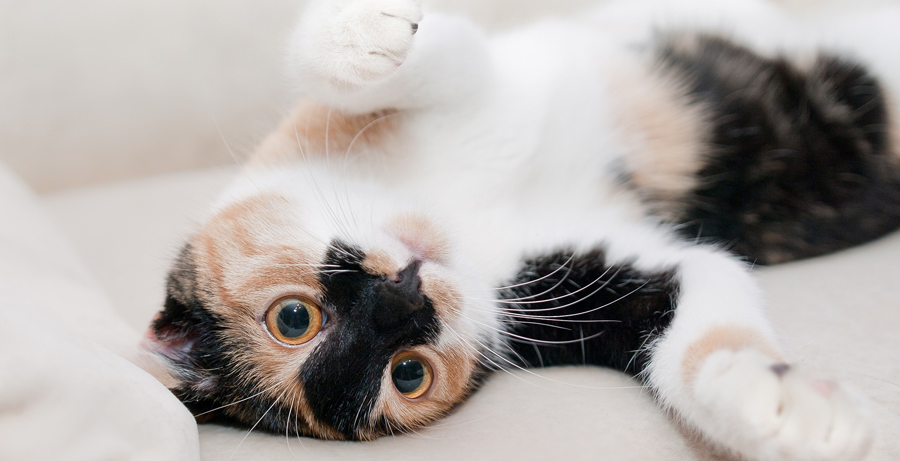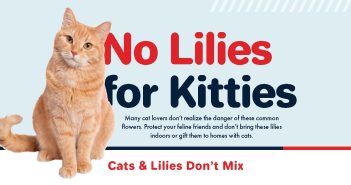Have you ever seen a cat stretch out on its back and seemingly invite you to give her belly a rub only to end up getting a death grip of claws on your hand in return? Me, too! Turns out cats who ‘roll over’ don’t necessarily expect a belly scratch, nor want one. The good news is you can save yourself from making such blunders if you learn how to figure out your felines feelings, before you go in for the tummy rub.
All it really takes is a little time and a little patient observation of what your cat’s ears, tail, and posture is telling you.
Do You Hear What I Hear?

Your cat hears what you hear, and then some. In fact, your cat hears more than your dog hears. And they hear in vivid variation. Cats’ ears also help keep them balanced and allow them to communicate with other cats . . . and with you, if you watch and learn from those little triangular satellite dishes.
There are 32 tiny muscles that allow your cat to rotate each ear up to 180 degrees, so variations are pretty far-ranging. However, there are a few basics to look for when you’re observing your cat’s ears for “feeling” cues:
- Ears forward and tall – all is well – go ahead and approach
- Ears laid back flat – all is NOT well – steer clear
- Ears sideways or downward – all might not be well – approach with caution and/or look for other cues
Tall Tails

Your cat is probably trying to communicate with you already by various tail movements and while sometimes they’re pretty subtle movements, sometimes they’re pretty obvious.
We’ve all seen a cat approach us with a stick-straight tail that nearly caresses you as they saunter by. Obviously that cat is happy and welcoming. Here are a few other clues to look for when you’re observing your cat’s tail for “feeling” cues:
- Tail tall with or without a curve – all is well
- Tail low, twitching and/or bushy – all is NOT well, back off
- Tail tucked – all might not be well – approach with caution because your cat is likely afraid
Purrfect Posture

Between the ears and tail, a cat has an entirely fluid body capable of expressing all kinds of emotions. There are so many postures a cat can take on, from a focused sphinx to a coiled-for-action hunter, decoding every possible combination can be a daunting task – especially if you don’t personally know the cat.
In general, here are a few basic poses to look for when observing your cat’s body posturing for “feeling” cues:
- On its back, belly exposed – relaxed and/or sleeping – do not startle that cat
- Head butting and licking – love and affection – consider yourself lucky
- Crouching tiger – ready to hunt – hopefully you’re not the one being stalked
Beyond the ears, tail and body gestures, cats also communicate with sounds. Even the deftest of non-cat-owning humans knows to back off from a hissing cat that’s cornered. And who amongst us can resist one of the best, most soothing sounds in the world – the contented purr.
Additional Resources
The purring quote above is from a book called, The Underneath, written by Kathi Appelt. If you’ve read and enjoyed books like The Yearling or Hurry Home, Candy, you’re probably going to like this book, too.
There is nothing lonelier than a cat who has been loved, at least for a while, and then abandoned on the side of the road.
A calico cat, about to have kittens, hears the lonely howl of a chained-up hound deep in the backwaters of the bayou. She dares to find him in the forest, and the hound dares to befriend this cat, this feline, this creature he is supposed to hate. They are an unlikely pair, about to become an unlikely family. Ranger urges the cat to hide underneath the porch, to raise her kittens there because Gar-Face, the man living inside the house, will surely use them as alligator bait should he find them. But they are safe in the Underneath…as long as they stay in the Underneath.
Hatchette Book Group
As for learning more about cat language, there’s a really good National Geographic book called How to Speak Cat: A Guide to Decoding Cat Language
in which Dr. Gary Weitzman offers up expert advice and real-life scenarios. Okay, it’s a book made for kids, but it’s full of insights and great pictures.
We know cats are beautiful, secretive, and independent … but even the most loyal cat owners are often baffled by their own pet’s behavior. With veterinarian expert Dr. Gary Weitzman as guide, this fun book helps kids understand what cats are trying to communicate by their body language and behavior. So if you’ve ever wondered what Fluffy means when she’s purring or moving her tail emphatically from left to right – this book is for you! It’s full of insights, expert advice, and real-life cat scenarios, and showcases more than 30 poses, so you’ll soon learn what each meow and flick of the tail means!
National Geographic Children’s Books

For more in-depth insight, The Secret Language of Cats by Heather Dunphy speaks to reading a cat’s expressions, body postures, behaviors, and noises. It also touches on how they might be interpreting our body language and it gives practical advice for training and for bonding with your feline friend.
Cats are often thought to be solitary and hard to read, but if you know what to look for, they possess a “secret language” that relies on expressions, body postures, behaviors, and noises. This language contains many subtle yet important nuances and is very different from human verbal communication, but it is nevertheless a language that can be learned. If “home is where the cat is,” then The Secret Language of Cats is where the answers are, providing fascinating and revealing insights into why cats act as they do. It also contains practical advice for training, addresses common health and behavioral problems, and suggests ways to strengthen the bond with your feline friend. Promptly and properly decoding feline messages is the key to both a contented cat and a confident owner. The Secret Language of Cats takes the mysteries out of cat body language, giving you the insight to gain a better understanding of your much-loved pet.
Amazon.com
Then there’s also Think Like a Cat: How to Raise a Well-Adjusted Cat–Not a Sour Puss
by Pam Johnson-Bennett, CABC (Certified Animal Behavior Consultant). From training cats to use a scratching post to tips on avoiding litter box problems, this book is often referred to as a feline behavior bible. In fact, Pam Johnson-Bennett is perhaps the most well known authority on all things feline and this revised edition doesn’t disappoint.
A fully revised and updated edition of the bestselling feline behavior bible. There are approximately eighty-five million cats owned as pets in the United States alone. And-thanks to her regular appearances in the media and at veterinary conferences and humane organizations-most of their owners already recognize Pam Johnson-Bennett as the authority on all things feline.Over the past ten years, the award-winning author has continued to refine her work and techniques. From basic health care to more serious behavioral issues, from training cats to use a scratching post to avoiding litter box problems this newly revised edition of Think Like a Cat covers all of a cat owner’s most pressing concerns-and solidifies its position as the topic leader for years to come.
And finally, if you need a handy reminder of the various cat posturing clues, this cat language infographic created by Lili Chin is just what you need!






